Turmeric's powerful antimicrobial compound, curcumin, helps your meat stay fresh longer in multiple ways. You'll benefit from its natural ability to fight both good and bad bacteria, including E. coli and Staphylococcus. When you combine turmeric with black pepper, it creates an even stronger preservative effect that can extend refrigerated meat's shelf life up to two weeks. It works well in marinades, during freezing, and as part of traditional curing methods. You can use it with various meats, from chicken to beef, and it'll protect against spoilage while adding rich, earthy flavor. There's even more to discover about this golden spice's preservation powers.
Natural Antibacterial Properties
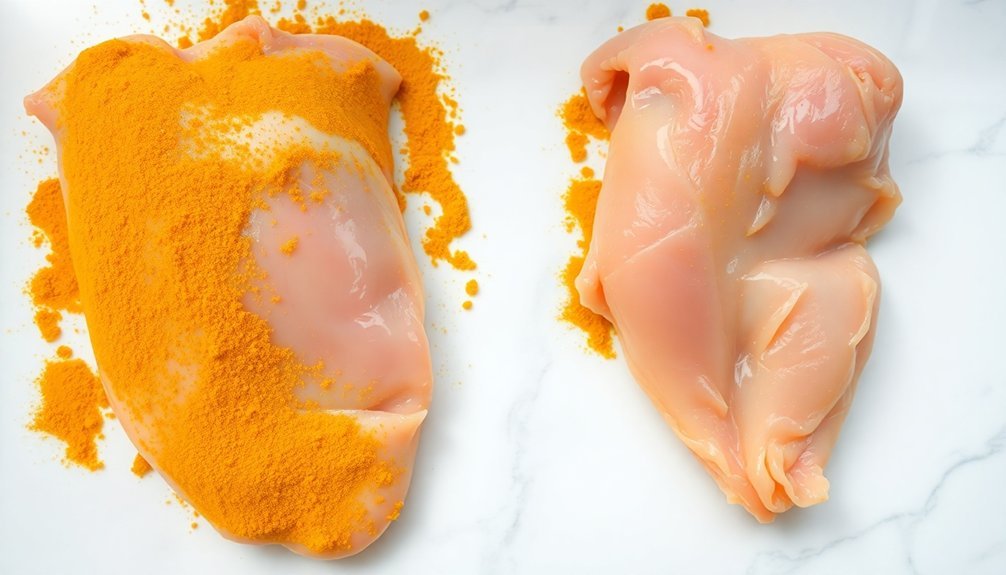
Turmeric's remarkable antibacterial properties make it a powerful natural preservative for meat products. When you add turmeric to your meat preparations, its active compound curcumin works directly against harmful bacteria like E. coli and Staphylococcus aureus, even at lower concentrations. The higher the concentration you use (up to 10 mg/mL), the more effective it becomes at inhibiting bacterial growth. Studies show turmeric extract is particularly effective against E. faecalis and L. innocua, making it ideal for fermented meat products.
What makes turmeric particularly effective is how it attacks bacteria. Its curcumin compound damages bacterial membranes, causing them to leak and ultimately destroying the cells. It also binds to the bacteria's peptidoglycan layer, disrupting their cell wall structure.
You'll find it's especially effective when combined with other ingredients that inhibit bacterial ATPase or contain mild detergents. You can count on turmeric to fight both Gram-positive and Gram-negative bacteria, making it versatile for meat preservation.
It's an excellent alternative to synthetic preservatives, and you'll find it particularly useful in high-moisture meat products. When you're preparing meat dishes at home, adding turmeric not only enhances flavor but also provides natural antimicrobial protection that works in a time and concentration-dependent manner.
Extended Refrigerator Storage Time
The proper storage of turmeric can greatly extend its refrigerator shelf life, keeping it fresh for up to two weeks. You'll want to start by thoroughly cleaning the turmeric root and patting it dry to prevent any mold growth.
Using a brown paper bag can help absorb excess moisture during storage.
Wrap the turmeric in a dry paper towel and place it in a resealable plastic bag before storing it in your refrigerator.
To maintain maximum freshness and potency, you should follow these essential steps:
- Cut the turmeric into smaller, manageable pieces and remove the skin if you're planning to freeze it.
- Store it away from direct sunlight and check regularly for signs of spoilage.
- Replace the paper towel when it becomes damp, and cut off any moldy spots as needed.
If you're looking for even longer storage options, you can freeze turmeric for up to six months, though you'll need to use it in minced or mashed form due to texture changes.
Alternatively, you can dehydrate fresh turmeric to create a powder that lasts up to nine months when stored in an airtight container. Regular monitoring guarantees you'll catch any quality changes before they affect your turmeric's usability.
Enhanced Freezer Preservation
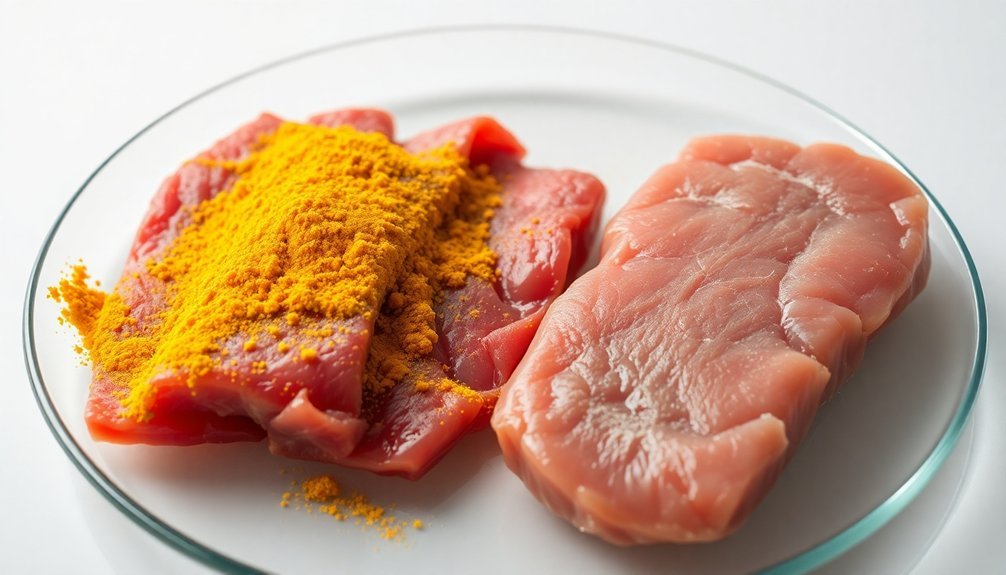
You'll find that turmeric-infused ice crystals form a protective barrier around meat during freezing, helping to lock in essential flavors and nutrients.
The extended cold storage benefits of turmeric become apparent as its natural compounds continue working to preserve meat's freshness even at freezing temperatures.
Fresh turmeric can maintain its potent medicinal properties when properly packaged and frozen alongside meat.
Turmeric-Infused Ice Crystals
Preservation experts have discovered that creating turmeric-infused ice crystals offers a powerful solution for maintaining meat freshness in the freezer.
These frozen cubes retain turmeric's potent antimicrobial properties while guaranteeing uniform distribution throughout your meat. You'll find that this method not only preserves freshness but also enhances flavor and extends shelf life more effectively than traditional preservation methods.
When you're working with turmeric ice crystals, you'll appreciate their convenience and consistent results. They eliminate the need to handle fresh turmeric root while providing the same powerful preservation benefits. The frozen crystals maintain their potency over time, making them ideal for long-term meat storage.
- Place turmeric ice crystals directly on your meat before freezing to guarantee even distribution of preservative compounds.
- Add the crystals to your marinades for enhanced tenderization and flavor preservation.
- Use them in combination with other natural preservatives to maximize freshness and food safety.
You'll notice that meat preserved with turmeric ice crystals maintains better color, texture, and taste even after extended freezer storage.
The uniform distribution of turmeric through this method helps protect against spoilage while providing consistent antimicrobial benefits throughout the meat.
Extended Cold Storage Benefits
During extended cold storage, turmeric's natural compounds work tirelessly to protect your meat from deterioration, even in freezer conditions. The curcumin in turmeric acts as a powerful preservative by fighting harmful bacteria that can survive at low temperatures, helping your meat stay safe and fresh for longer periods.
You'll benefit from turmeric's antioxidant properties, which prevent oxidation and reduce the formation of lipid peroxides that cause rancidity. This means your frozen meat won't develop that unpleasant freezer taste or lose its natural color and texture.
The spice's ability to inhibit enzymatic reactions also plays a significant role in maintaining your meat's structural integrity throughout extended storage.
When you combine turmeric with other preservatives, you'll get even better results. This natural combination creates a robust preservation system that addresses multiple forms of food spoilage simultaneously.
You won't need to rely heavily on artificial preservatives, as turmeric's antimicrobial and antioxidant properties work together to maintain meat quality. By incorporating turmeric into your meat storage routine, you're choosing a natural way to extend shelf life while preserving flavor, texture, and nutritional value.
Flavor Lock During Freezing
Turmeric's remarkable ability to lock in flavors shines brightest when combined with proper freezing techniques. When you're preserving meat with turmeric, the key lies in how you store both ingredients to maintain their potency. The active compounds in turmeric, particularly curcumin, work as natural preservatives while adding that distinctive warm, earthy flavor to your proteins.
To maximize turmeric's flavor-locking potential during freezing, follow these essential steps:
- Remove all air from your storage bags before sealing – this prevents freezer burn and maintains turmeric's ability to protect the meat's flavor.
- Freeze your turmeric-seasoned meat flat in zipper-lock bags for quicker freezing and thawing, which helps preserve both texture and taste.
- Consider preserving your turmeric in oil before adding it to meat – this creates a natural barrier that locks in the spice's essential oils and compounds.
You'll find that properly frozen turmeric maintains its potency and medicinal properties much longer than fresh alternatives. By using airtight containers and consistent freezing methods, you're ensuring that both your turmeric and meat retain their prime flavor profiles throughout storage.
Marinades for Meat Protection
Crafting effective marinades with turmeric, garlic, and chili paste can greatly boost meat's shelf life while maintaining its quality. When you combine these ingredients, you'll create a more potent preservative effect than using them separately. The curcumin in turmeric, allicin in garlic, and alkaloids in chili paste work together to protect your meat from spoilage.
You'll want to mix your marinade with oils or fats to help it penetrate the meat more effectively. For best results, let your meat marinate for at least an hour, though you can extend this up to 24 hours. Remember to store your marinated meat at 4°C in the refrigerator. You can enhance turmeric's effectiveness by adding black pepper to your marinade.
This preservation method works well with various meats, including beef and duck. You'll need to monitor your marinated meat's quality by checking for signs of bacterial growth, particularly Salmonella and E. coli.
Keep track of the meat's pH, weight loss, and texture to guarantee it maintains its quality. This marinade approach offers flexibility in your recipes while providing practical preservation benefits.
Slowing Bacterial Growth
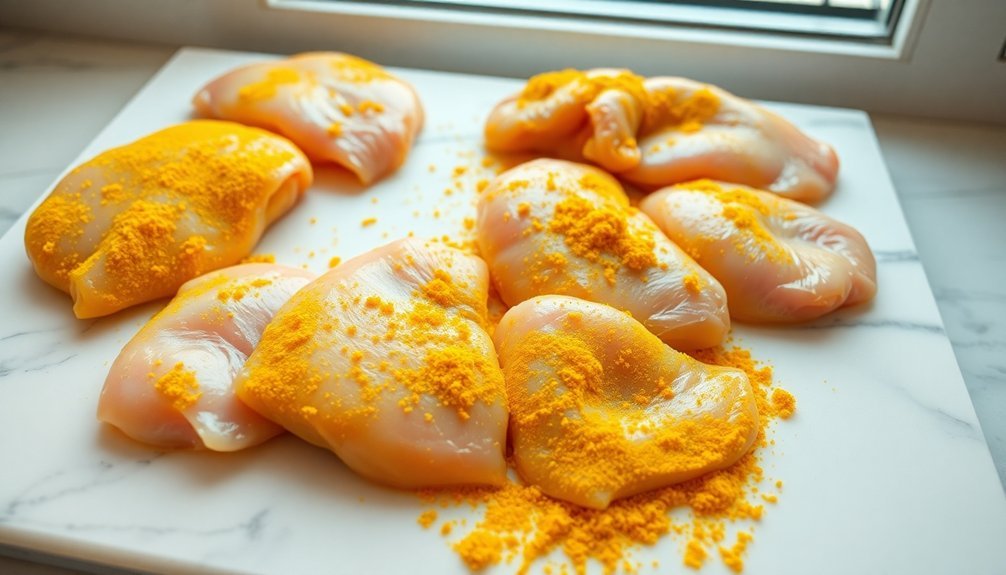
You'll find that turmeric works as a powerful natural antimicrobial agent, targeting both Gram-positive and Gram-negative bacteria through multiple mechanisms like cell wall disruption and enzyme inhibition.
While studies show varying effectiveness in meat applications, turmeric's ability to block harmful microorganisms stems from its active compound curcumin, which can alter bacterial cell membranes and prevent biofilm formation.
Your meat's safety benefits from turmeric's temperature-resistant protective qualities, which remain active during storage and can be enhanced through proper preparation methods and concentration levels.
Natural Antimicrobial Action
Known for its vibrant color and distinctive flavor, turmeric contains powerful antimicrobial properties that can naturally slow bacterial growth in meat products. The secret lies in curcumin, turmeric's active compound, which works by disrupting bacterial cell membranes and interfering with their growth processes.
You'll find it's most effective when used in higher concentrations, typically between 1-5%, especially in acidic environments.
When you're looking to preserve meat naturally with turmeric, keep these key points in mind:
- The antimicrobial effect works best at higher concentrations – don't be shy with the amount you use, as studies show that concentrations below 1% mightn't be effective enough.
- You'll get better results in acidic conditions, so consider combining turmeric with acidic marinades or ingredients.
- Storage temperature matters – keep your turmeric-treated meat at 4°C for ideal preservation.
For the best results, you might want to combine turmeric with other natural preservatives. Its antioxidant properties work alongside its antimicrobial effects, giving you a powerful duo that not only fights bacteria but also prevents oxidation in your meat products.
Blocking Harmful Microorganisms
Throughout decades of research, turmeric's curcumin compounds have demonstrated remarkable abilities to block harmful microorganisms in meat products. These polyphenolic compounds work by disrupting bacterial cell membranes and inhibiting bacterial enzymes, making them effective against various pathogens that commonly affect meat.
You'll find that turmeric's antimicrobial properties are particularly relevant when it comes to fighting bacteria like E. coli and Staphylococcus aureus in chicken meat. While studies show mixed results at low concentrations (1%), you can enhance turmeric's effectiveness by using higher concentrations or combining it with black pepper to improve its bioavailability.
When you're looking to protect your meat products, you can apply turmeric in two ways. You can use it as a direct meat treatment, or it can be incorporated into animal feed to improve gut health and reduce disease incidence.
However, you should note that the effectiveness depends on several factors, including concentration levels and application methods. For best results, you'll need to guarantee proper storage conditions and consider using higher concentrations of turmeric than the standard 1% to achieve significant antimicrobial effects.
Temperature-Resistant Protection
Turmeric's temperature-resistant properties make it an exceptional natural preservative for meat products, particularly in challenging storage conditions.
You'll find that turmeric remains stable under various heat treatments, including boiling and microwaving, while maintaining its protective compounds that keep meat fresh. This stability guarantees that the meat's lipid profile stays balanced, with high levels of unsaturated fatty acids preserved even after heat exposure.
The temperature resistance of turmeric works in your favor through three key mechanisms:
- It continues to support gut health in poultry by enhancing nutrient absorption and maintaining digestive enzyme activity, resulting in healthier meat that stays fresh longer.
- Its antioxidant properties remain active even after heat treatment, preventing lipid peroxidation and reducing oxidative stress that can lead to meat spoilage.
- The immunomodulatory effects persist, helping reduce the need for antibiotics and guaranteeing healthier poultry that produces fresher meat.
You'll notice that turmeric's ability to maintain stable water activity in meat products, combined with its heat-resistant properties, creates an effective barrier against spoilage, even when storage conditions aren't ideal.
Reduced Food Waste
In the battle against food waste, turmeric serves as a powerful ally for extending meat's shelf life and reducing spoilage. When you marinate meat in a turmeric and salt solution, you'll create an environment that actively inhibits bacterial growth and slows down lipid oxidation, thanks to turmeric's potent antioxidant properties and its active compound, curcumin.
You can greatly extend your meat's shelf life by using this simple preservation method. When stored properly, turmeric-marinated meat can stay fresh for more than a week, and in some cases, even several weeks to months. This means you won't have to make frequent trips to the store, and you can confidently buy meat in bulk without worrying about spoilage.
You'll find this method particularly cost-effective since it uses readily available ingredients. By preventing premature spoilage, you're not just saving money but also reducing your environmental impact.
The versatility of turmeric preservation means you can apply it to various types of meat, from chicken to beef, using different techniques like marinating, fermenting, or combining it with vacuum sealing for ideal results.
Safe Long-Term Storage Solutions
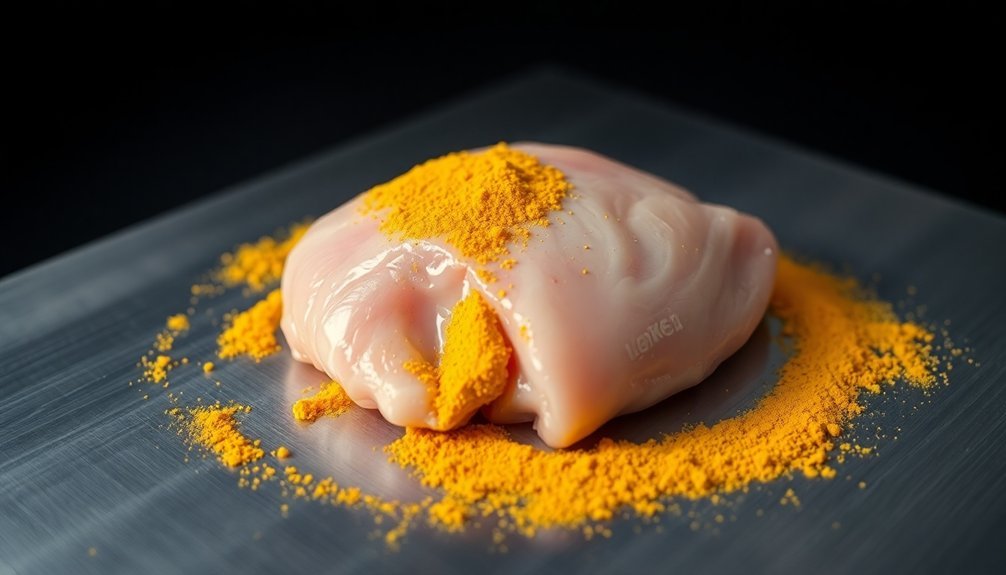
Safe storage solutions for turmeric-treated meat require careful attention to both temperature and packaging methods.
You'll need to start with proper sealing techniques, using vacuum-sealed bags or airtight containers to prevent oxidation and microbial growth. When incorporating turmeric into your meat preservation routine, combine it with oil-based marinades for enhanced effectiveness.
For ideal long-term storage, you've got three primary options:
- Freeze your turmeric-treated meat at -18°C (0°F), ensuring it's properly wrapped to prevent freezer burn and maintain quality for several months.
- Store marinated cuts in the refrigerator below 3°C (38°F), using the first-in, first-out method to manage your supply effectively.
- Consider vacuum sealing your meat with turmeric-based rubs or marinades to maximize shelf life and preserve flavor.
You can also boost preservation by combining methods – for example, vacuum sealing before freezing provides double protection.
When working with ground meats, mix turmeric directly into the meat before storage to prevent oxidative changes.
Remember to maintain strict hygiene practices during preparation and storage, as cleanliness is essential for preventing contamination and ensuring your preservation efforts are successful.
Protection Against Harmful Microorganisms
The antimicrobial power of turmeric lies in its active compound, curcumin, which protects meat against harmful bacteria and other microorganisms. When you use curcumin-based treatments, you'll find they're particularly effective against common meat contaminants like E. coli and S. aureus, especially when combined with blue light exposure.
You'll get the best results when you use pure curcumin rather than whole turmeric, as studies show that 1% turmeric alone doesn't markedly reduce bacterial counts in chicken breast. However, when you combine curcumin with other preservation methods like refrigeration, you'll enhance its protective effects against harmful microbes.
What makes curcumin particularly interesting is its ability to prevent bacterial biofilm formation through the quorum sensing system. While it won't destroy existing biofilms, it'll stop new ones from forming.
You can also maximize curcumin's effectiveness by using it in a cyclodextrin complex, which becomes even more potent when exposed to blue light. This combination triggers the production of reactive oxygen species that kill bacteria.
For the best protection, you'll need to verify proper concentration and application methods, as these factors considerably influence curcumin's antimicrobial efficacy.
Spice-Based Preservation Techniques
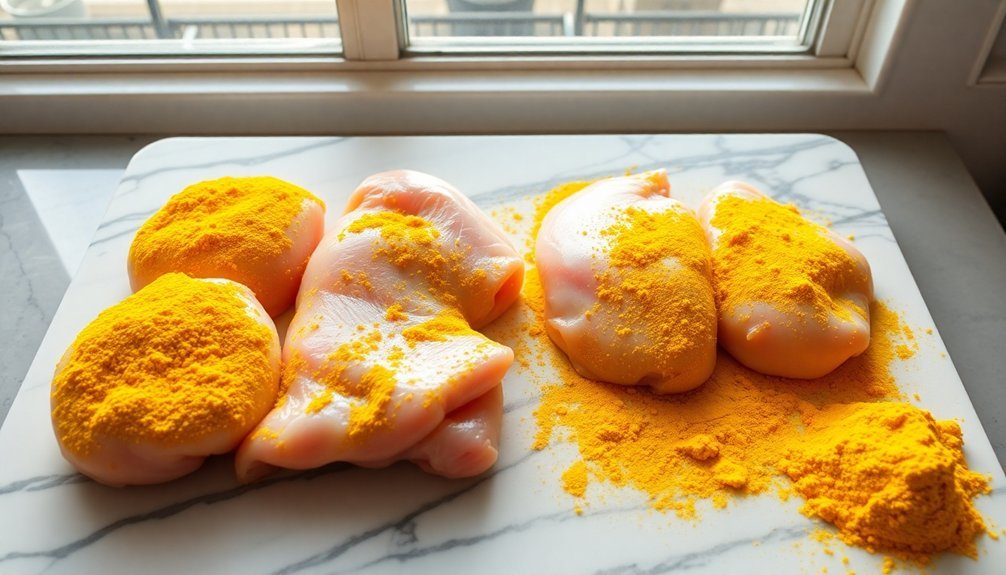
Modern spice preservation methods rely heavily on turmeric's versatile properties when combined with other natural preservatives. You'll find that turmeric works best when it's integrated into traditional preservation techniques, especially when paired with complementary spices like black pepper, garlic, and paprika. These combinations enhance both the preservative effects and flavor profile of your meat products.
You can incorporate turmeric into your meat preservation routine through several proven methods:
- Mix it into your curing solutions alongside salt, sugar, and nitrates to create a powerful preservation blend that fights bacterial growth.
- Add it to your brining mixtures to enhance the antimicrobial properties while maintaining proper water activity levels.
- Use it in oil-based marinades and rubs, where it'll work double duty as both a preservative and flavor enhancer.
When you're working with turmeric for meat preservation, remember that it's particularly effective in controlling lipid oxidation and maintaining stable pH levels.
You can apply these techniques to various meat products, from meatloaf to dried jerky, but always verify you're storing the treated meat properly in airtight containers under refrigeration for ideal results.
Traditional Meat Storage Methods
Throughout history, successful meat preservation has relied on several time-tested storage methods that you'll still find relevant today.
Cold storage remains one of the most common approaches, with refrigeration slowing bacterial growth for up to 7 days and freezing extending preservation for months at −18°C.
You'll find that drying and dehydration offer effective long-term solutions by removing moisture that bacteria need to thrive. Whether you're making jerky or dry sausages, these methods allow for room temperature storage without rapid spoilage.
Salting and brining work similarly by drawing out moisture while adding flavor.
Fermentation and curing techniques transform your meat through beneficial bacteria and salt combinations. You'll notice these methods in popular products like bacon, ham, and fermented sausages. The process not only preserves the meat but also creates distinct flavors.
For modern preservation, you can't overlook canning and vacuum packaging.
Canning provides indefinite shelf life at room temperature when properly sealed, while vacuum packaging extends refrigerated storage to about 100 days by removing oxygen that bacteria need to grow. These methods effectively prevent both moisture loss and microbial contamination.
Frequently Asked Questions
Can Turmeric Stains From Meat Marinades Be Removed From Kitchen Surfaces?
You can remove turmeric stains from kitchen surfaces using baking soda paste, lemon juice, or vinegar. Let the cleaning solution sit for 15 minutes, then gently scrub in circles and rinse clean.
Does Turmeric-Preserved Meat Change Color When Cooked?
Yes, when you cook turmeric-treated meat, you'll notice it shifts from its raw yellow color to a deeper golden hue. The yellow coloring from turmeric remains visible and won't produce the pink shade of cured meats.
How Much Turmeric Is Needed per Pound of Meat for Preservation?
Based on research, you'll need more than 1% turmeric by weight, as lower amounts aren't effective for preservation. For one pound of meat, that's at least 4.5 grams (roughly 1.5 teaspoons) of turmeric.
Can Turmeric Be Combined With Other Natural Preservatives Like Vinegar?
Yes, you can combine turmeric with vinegar as a natural preservative. While there aren't specific studies on this combination, both ingredients have antimicrobial properties that may work together to enhance food preservation effectiveness.
Will Turmeric Preservation Affect the Meat's Nutritional Value?
No, you won't lose nutritional value when using turmeric as a preservative. It actually helps protect your meat's nutrients by preventing oxidative damage, while maintaining the original nutritional profile of your food.
In Summary
You'll find turmeric is a powerful natural preservative for keeping your meat fresh longer. By incorporating this golden spice into your marinades and storage methods, you're not only enhancing flavor but also protecting your food through its antibacterial properties. Whether you're storing meat in the fridge or freezer, turmeric helps fight harmful microorganisms and extends shelf life, making it an essential addition to your food preservation routine.





Leave a Reply